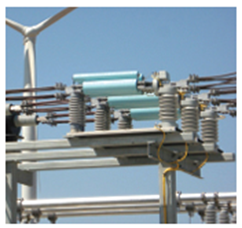Fault Energy Limiting Fuses
Risk Reduction Category
Technology Description
A line-to-line or line-to-ground fault commonly results in the ionization of air (or arcing), which can be directly attributable to ignition of a fire when a fuel source is present. In a common scenario, a tree branch falling into a distribution circuit causes a fault while also supplying the ignition fuel. A second risk of ignition occurs when an arcing fault releases molten material to the ground. Circuit protection is designed to protect the utility infrastructure and humans during a fault. However, until the protection operates, an arc can be developed and will be sustained for as long as sufficient electrical energy is available.
Reducing the fault energy (by reducing peak current) significantly reduces the magnitude and duration of an arc. In the context of wildfire prevention, the purpose is to reduce the likelihood of ignition.
Current-limiting fuses are a mature technology for low voltage circuits, but are not widely used in transmission or distribution because of high cost and some technical limitations. Current limiting fuses are not suitable for cold starting loads. They must therefore be bypassed during startup and put into service when needed.
The “CLiP” (Current Limiting Protector), a product manufactured by G&W Electric (Figure 1), is an application of a current limiting fuse for distribution circuits that can be put into and taken out of service via SCADA. The CLiP might be considered by a utility that has frequent fire risk events. A utility with infrequent fire risk may opt for a more cost-effective deployment of current limiting fuses that require manual activation.

Technical Readiness (Commercial Availability)
Current limiting fuses are a mature technology that is readily available. However, depending on the use case, there may be some important unknowns to consider. For example:
- Methods to place current limiting fuses into and out of service (CLiP is available from one vendor).
- How close to load limits can current limiting fuses be sized? (smaller sizing may result in additional fault limiting)
- How will fault indicators and traditional fuses behave in areas protected by current limiting fuses?
- Will the reduction in energy be enough to prevent an ignition in all cases?
Disadvantages of current limiting fuses are as follows:
- Current limiting fuses do not work well with low current faults. Care must be taken to size them correctly.
- Current limiting fuses can cause current chopping which may result in transients when low current levels occur, such as during a cold-load pickup event. The current limiting fuse portion of the CLiP device is bypassed most of the time until a SCADA command is sent.
- Current limiting fuses be impacted by inrush. Thus, they cannot be in service all the time.
Vendors with Hardware and Software
G&W Electric
https://www.gwelectric.com/products/current-limiting-system-protection/clip/
Implementations / Deployments
The CLiP device is an established product utilized by many utilities in substations that have an available fault current that exceeds the ratings of their distribution breakers. CLiP devices are installed in lieu of replacing the feeder breakers with high fault interrupting devices. If the high fault current is only available during specific conditions, such as when banks are paralleled, the CLiP may only be in service when the high fault current conditions exist.
References
https://dev.gwe.lightburncloud.com/webfoo/wp-content/uploads/GW12-2019-CLiP-Bro-FINAL-0722.pdf